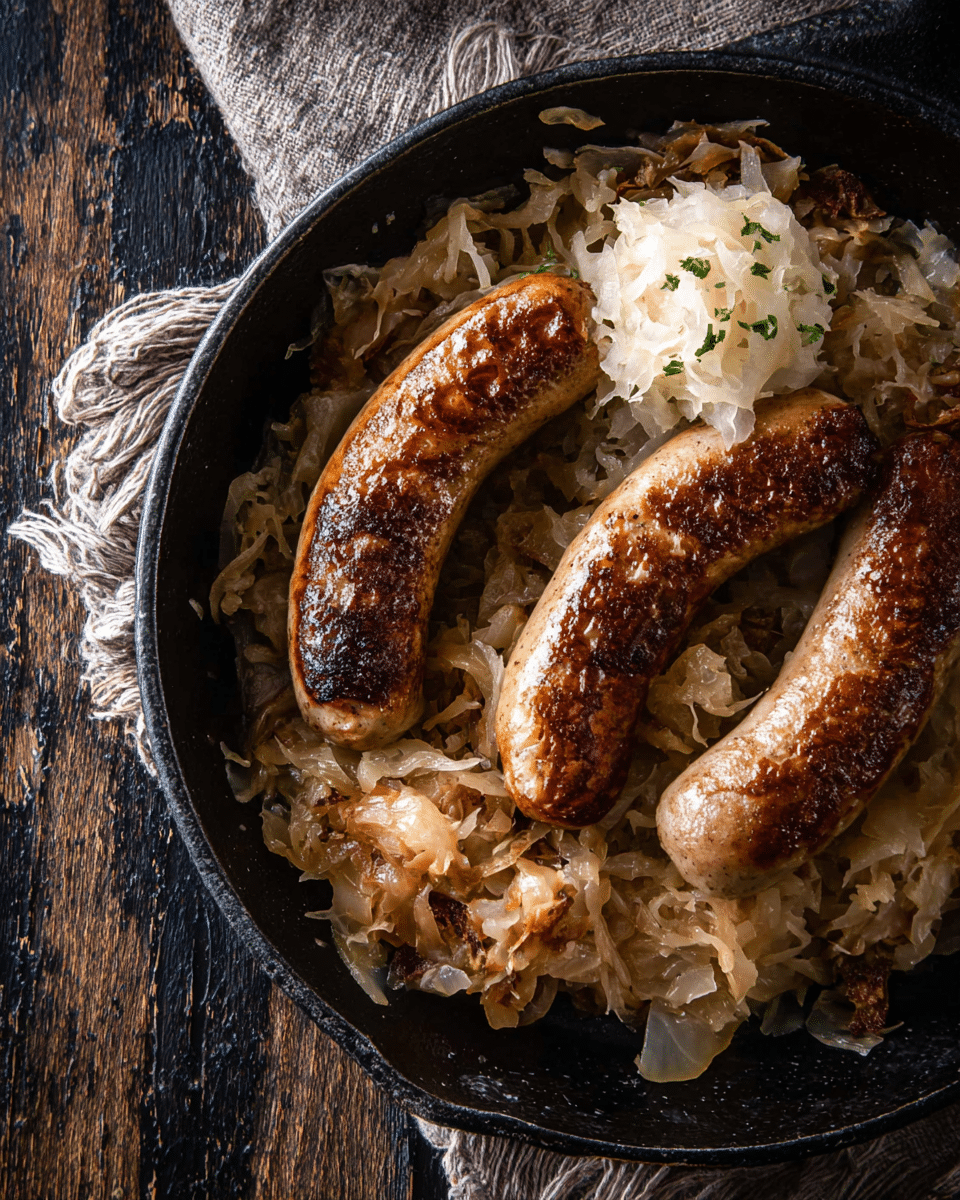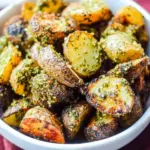The classic pairing of bratwurst and sauerkraut is a time-honored German favorite for good reason — it’s simple, hearty, and full of bold flavors. This one-skillet dish features juicy sausages braised atop apple- and bacon-infused sauerkraut, with subtle notes of caraway, juniper, and sweet maple tying it all together.
Whether served on a plate with mustard and crusty bread or tucked into a bun with spicy pickles, this is comfort food done right. It’s a great choice for fall gatherings, chilly weeknight dinners, or anytime you’re craving old-world flavors made easy. Your kitchen will smell divine!
Full recipe:
Ingredients:
-
4 bratwurst sausages
-
1 jar (about 1 quart) plain sauerkraut (do not rinse)
-
½ cup bacon, diced (optional but recommended)
-
1 cup chicken or beef bone broth (or water + bouillon cube)
-
1 tablespoon neutral oil or animal fat (like lard or tallow)
-
1 large yellow onion, thinly sliced
-
1 apple, chopped (preferably tart, like Granny Smith)
-
4 tablespoons maple syrup or honey (or brown sugar)
-
1 bay leaf
-
5 juniper berries (optional)
-
5 caraway seeds (optional)
-
Salt & freshly ground black pepper to taste
-
Optional for serving: buns, spicy mustard, pickles, hot peppers
Directions:
-
Preheat oven to 350°F (175°C).
-
Drain the sauerkraut using a colander but do not rinse.
-
In a large, oven-safe skillet or pot, heat the oil or fat over medium-high heat. Sear the bratwursts until browned on all sides, then remove and set aside.
-
In the same skillet, lower heat to medium. Add diced bacon and sliced onions. Sauté until bacon is crispy and onions are golden.
-
Add chopped apple and cook for another 2-3 minutes, stirring frequently.
-
Stir in ground black pepper, juniper berries, caraway seeds, maple syrup, broth, and the bay leaf. Mix well to combine.
-
Add the drained sauerkraut to the pan and stir gently. Nestle the bratwursts on top of the mixture.
-
Cover the skillet with a lid and transfer to the oven. Braise for 45 minutes.
-
Remove the lid. If there’s too much liquid, remove the sausages and reduce the sauerkraut on the stovetop until thickened.
-
Return sausages to the pan, adjust seasoning with salt and pepper, and serve hot — either on a plate or in a bun with traditional toppings.
Prep Time: 15 minutes | Cooking Time: 45 minutes | Total Time: 1 hour
Kcal: 546 kcal | Servings: 4
The Origin of Bratwurst and Sauerkraut
The word bratwurst is derived from Old High German: “brät” meaning finely chopped meat and “wurst” meaning sausage. German sausage-making dates back hundreds of years, with different regions across Germany crafting their own unique styles of bratwurst, each characterized by varying spice blends and meats (pork, veal, or beef).
Sauerkraut, which translates to “sour cabbage,” is a form of fermented cabbage that has been a dietary mainstay in many parts of Europe due to its longevity, digestive benefits, and vibrant flavor. It’s naturally preserved through fermentation, allowing it to be stored and eaten throughout the winter months when fresh produce was historically scarce.
Together, bratwurst and sauerkraut became a logical culinary marriage — a protein-rich, filling, and gut-friendly combination that could easily be made in large batches and flavored according to family and regional preferences.
Why This Recipe Stands Out
What sets this recipe apart is the balance of flavors and textures that is achieved through thoughtful layering of ingredients. While many bratwurst and sauerkraut recipes keep it minimal, this version includes a few key additions that elevate the dish without overcomplicating it.
First, the use of bacon adds richness and depth, while apples bring a natural sweetness that balances the tanginess of the fermented sauerkraut. The onions are sautéed until golden, adding a mellow sweetness and savory body to the base. Maple syrup or honey enhances the sweet-and-sour effect, playing perfectly against the smoky seared bratwurst.
Optional spices like juniper berries and caraway seeds deepen the flavor even further, introducing slightly piney and earthy notes that are traditionally found in authentic German preparations. All of this comes together in a single skillet or pot, making it both easy to clean up and ideal for a rustic presentation.
Cooking Method and Technique
While the ingredients are important, the technique is equally crucial. The dish starts on the stovetop, where the sausages are browned to develop flavor through the Maillard reaction. Then, the aromatics and flavor-building ingredients are cooked in the same skillet, infusing the base of the dish with richness.
Finally, everything is braised in the oven — covered and left alone — allowing the flavors to meld while the sauerkraut softens and the sausage cooks through. This low-and-slow method means that the entire dish becomes deeply flavorful, moist, and tender without any fuss. For those who enjoy reducing the liquid slightly for a more concentrated sauce, a brief return to the stovetop can adjust the consistency.
This preparation not only develops complex flavors but also showcases a traditional way of cooking that prioritizes patience, care, and simplicity. It’s a method that brings out the best in humble ingredients and transforms them into something greater than the sum of their parts.
Versatility and Substitutions
One of the best things about this dish is how adaptable it is. While bratwurst is the classic choice, this recipe works with other types of sausage like kielbasa, weisswurst, or even spicy Italian sausage for a twist. Pork remains the traditional protein, but chicken sausages are also a leaner alternative for those looking to reduce fat content.
Sauerkraut is a must, but you can choose between canned, jarred, or homemade versions. Each has its own level of tang and saltiness, which can subtly change the final result. If you’re sensitive to strong fermented flavors, you can gently rinse the sauerkraut before use — although many purists would advise against it.
The addition of apple is recommended, but you can also experiment with pears for a softer sweetness. Bacon can be left out for a vegetarian-friendly version (if using meat-free sausage), and maple syrup can be swapped with brown sugar or even a sugar-free alternative if preferred.
Broth is the best choice for braising as it enriches the entire dish, but water with a bouillon cube is perfectly acceptable. This flexibility makes the dish approachable for a range of dietary needs, personal tastes, and available pantry items.
Serving Suggestions
Bratwurst and sauerkraut is highly customizable in how it’s served. It can be plated simply with a side of rustic bread or spooned into a bowl for a cozy, fork-and-knife kind of meal. Alternatively, it can be turned into a sandwich by tucking the sausages into crusty buns and topping them with sauerkraut, spicy mustard, pickles, and hot peppers.
In Germany, it’s common to enjoy this dish with sides like spaetzle (soft egg noodles), warm potato salad, or creamy mashed potatoes. For a low-carb option, serve it with roasted vegetables or cauliflower mash.
No matter how you present it, the dish’s heartiness and rich flavor profile make it a crowd-pleaser — equally appropriate for a casual weeknight meal or a themed dinner gathering.
Cultural Significance
This dish isn’t just food — it’s a celebration of culture. Bratwurst and sauerkraut evoke images of German beer halls, cozy family dinners, and hearty Oktoberfest platters. It’s a dish that’s been passed down through generations, carrying with it memories, tradition, and comfort.
For those with German heritage, making this dish can be a way to reconnect with their roots. For others, it’s an introduction to the robust, satisfying flavors of Central European cooking. In either case, it brings people together over a shared love for good food prepared with intention.
Make-Ahead and Storage Tips
Another excellent quality of this recipe is how well it stores. The sauerkraut continues to absorb flavors as it sits, making leftovers even tastier the next day. The entire dish can be stored in an airtight container in the refrigerator for several days, either with the sausages and kraut together or separately.
Reheat it gently on the stovetop with a splash of broth or water to loosen it up, or microwave it in portions for a quick lunch. This dish also freezes well — just wrap the sausages and sauerkraut separately for best results and thaw overnight in the fridge before reheating.
It’s a great option for batch cooking, meal prep, or simply ensuring you always have something hearty and homemade on hand.
Health and Nutritional Considerations
While hearty, this dish offers several nutritional benefits. Sauerkraut is known for being probiotic-rich, which supports gut health, digestion, and immunity. When it’s not overly cooked, many of these beneficial bacteria can remain intact, making this a functional food as well as a flavorful one.
Bratwurst is high in protein, making the dish satisfying and suitable for those following high-protein or low-carb diets. The apple adds natural fiber and vitamins, while the broth-based cooking method helps keep things moist without needing excess fat.
For a leaner version, opt for poultry-based sausage and skip the bacon, or use a smaller amount of natural sweetener. Regardless, the balance of macronutrients in this dish makes it a complete meal, especially when paired with a side of veggies or whole grains.
Conclusion
Bratwurst and sauerkraut is a dish that’s stood the test of time — and for good reason. It’s rustic yet refined, bold yet comforting, and incredibly adaptable to different preferences and diets. Whether you’re cooking for a special occasion, embracing your cultural roots, or just looking for something warm and filling to make on a chilly evening, this dish delivers.
More than just food, it’s an experience: the sizzle of the sausage, the tang of the kraut, the aroma of caramelizing onions and bacon. It’s a meal you’ll crave again and again, and one that’s bound to become a beloved staple in your kitchen.
From its historical significance to its modern-day versatility, bratwurst and sauerkraut represents everything that’s wonderful about traditional home cooking — flavorful, hearty, and made to be shared.






